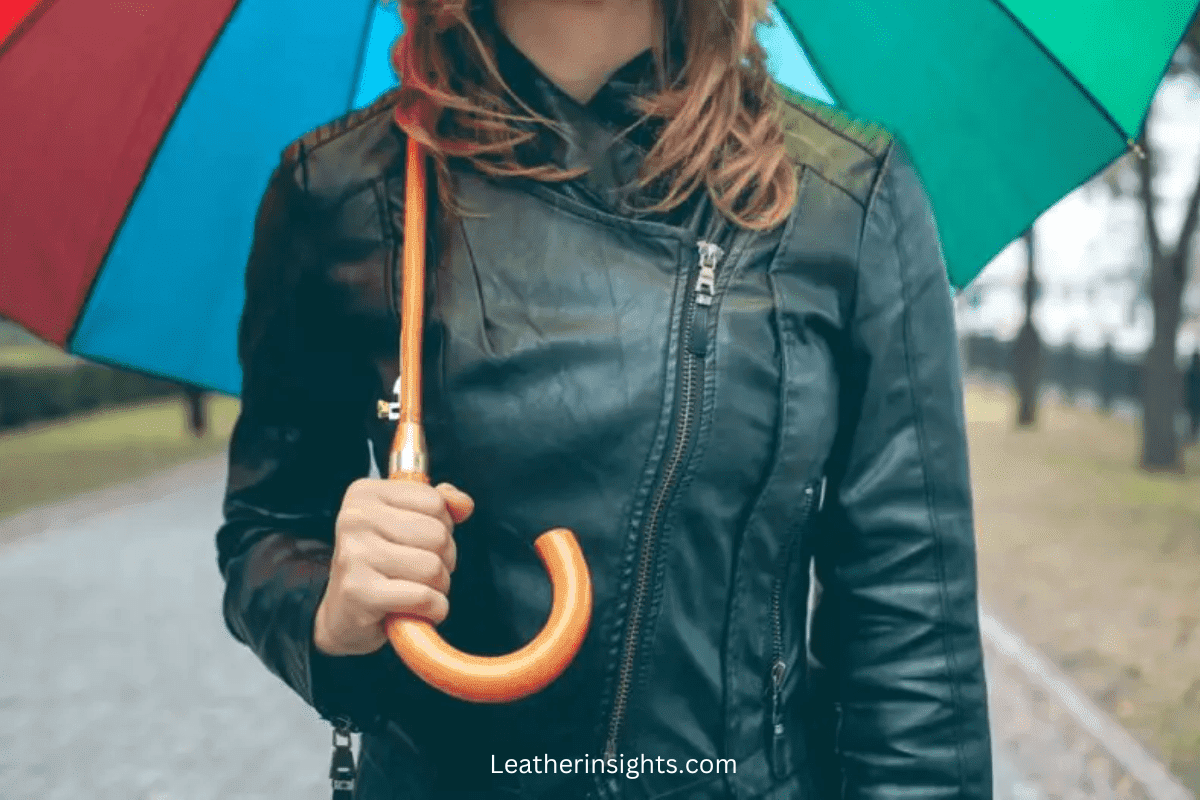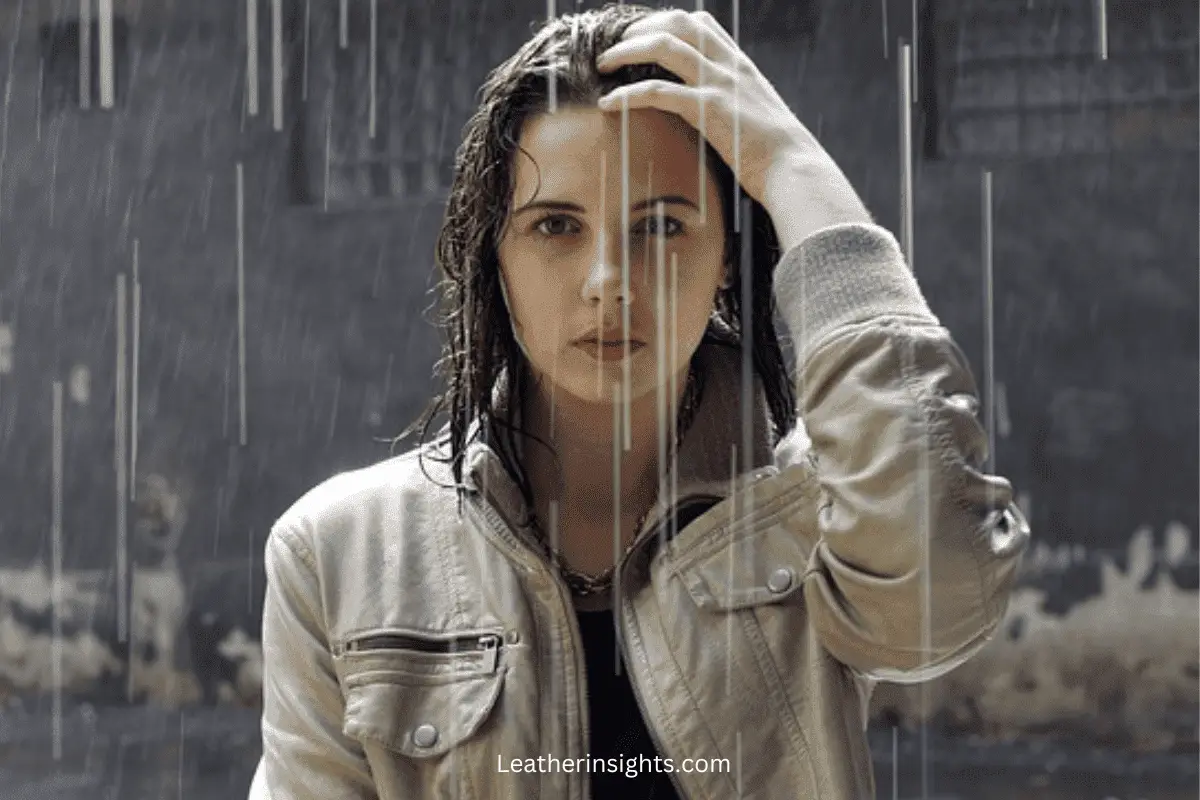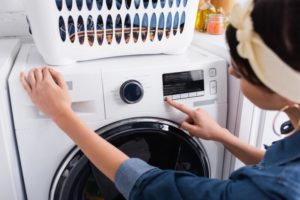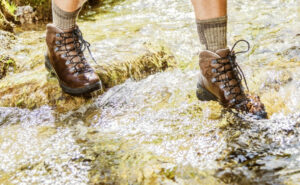Wearing Leather Jacket in the Rain
Leather jackets are super versatile and can be worn year-round with a variety of outfits.
But, you might be wondering, can you wear them in the rain?
While leather jackets can withstand light rain, it is important to use a good waterproofing product to protect them from heavy rain.
This article will discuss the effects of water on leather jackets and how to dry them properly. Plus, we’ll share tips on how to protect your jacket from the rain and suggest some great waterproofing products to keep it in top condition.

Can leather jackets get wet?
There is no doubt that a leather jacket will keep you warm in cold conditions. But, it can get wet when exposed to rain or water.
Leather is a natural material made from animal skin, and like human skin, it can absorb water.
However, it’s important to note that not all types of leather are created equal. Some types of leather like suede and nubuck are more porous and prone to water damage than others.
I remember a time when I got caught in the rain while wearing my suede boots. By the time I made it home, my boots were soaked, and the suede looked completely ruined.
On the other hand, leather jackets made from high-quality, full-grain leather are more resistant to water damage.
I’ve worn my full-grain leather jacket in light rain before and it has held up well without any noticeable damage.
However, if exposed to heavy rain for an extended period, the leather can become saturated and start to lose its natural oils, making it brittle and prone to cracking
Can you wear a leather jacket in the rain?
While it’s okay to wear a leather jacket in the rain, exposure to water or moisture over an extended period of time can ruin it. This is because leather is porous so it absorbs water and gets wet if it does not have a protective finish.
What happens when you get leather wet?
here are some of the reasons why you should avoid wearing your leather coat in the rain;
1. Leather gets wet and heavy
Leather jackets are already heavy, and when they get wet, they can become even heavier and more uncomfortable to wear.
When you expose your jacket to heavy rain or water over a long period of time, the protective finish is stripped away.
This exposes the leather and allows water to pass through its pores. As a result, your leather coat gets soaking wet and heavy.
2. Water strips the natural oils in leather
When leather gets wet, the water causes the natural oils in the material to evaporate. These oils help keep the leather soft, flexible, and durable.
So without these oils, the leather can become stiff and dry leading to cracks and permanent damage that cannot be reversed.
In addition, the water can cause the leather to absorb unwanted moisture, which can further damage the material.
3. Stains and discolors
Your leather jacket might also stain and discolor if exposed to heavy rain and not dried properly.
This is because rainwater contains minerals and pollutants that can seep into leather and cause discoloration and a dull appearance.
Also, these pollutants can weaken the leather and make it more susceptible to damage over time.
However, this is likely to happen if your leather jacket is not treated with a protective finish.
For instance, you may experience staining and discoloration if your jacket is made from aniline leather, which is not surface treated.
Aniline leather tends to get wet easily and stains quite fast too. For this reason, jackets made from aniline leather discolor when they get wet.
4. Deteriorates and rots
When leather gets wet, it might take a while to get it to dry completely since the fibers are soaked with water.
If not dried properly, your leather jacket may become susceptible to mold and mildew growth, which thrive in moist conditions.
With time, you may start noticing a pungent smell due to the mold. The jacket may also start to weaken and rot as the microorganisms eat away at the leather.
5. Shrinks or stretches
Another effect is that the leather can shrink, stretch, and lose its shape when exposed to water, resulting in a poorly fitting jacket.
This is due to the fact that leather is a natural material that can be affected by water in different ways depending on the type of leather and how it was treated.
Shrinkage can happen if the leather dries too quickly, causing it to contract and become smaller in size.
Stretching on the other hand can occur if the leather becomes too wet, causing it to lose its structure and become larger and less form-fitting.
How to protect your leather jacket from rain
Since leather is permeable, leather jackets, shoes, pants, or boots get wet when rained on as water sips through deep into the fibers.
You can however prevent this by waxing or conditioning your leather jacket regularly. Using a suitable leather wax or conditioner will help to create a barrier on the surface of the coat and prevent water from getting absorbed into the leather.
Follow these steps to protect your jacket:
-
Apply wax
One way to increase the water resistance of your leather jacket is by applying wax.
Wax adds a waterproof layer on the surface of the leather that prevents water from soaking into the jacket. It also adds a beautiful shine to the jacket so that it keeps looking fresh and new.
There are many types of waxes available but Nikwax waterproofing wax is highly recommended. Nikwax instantly provides a durable water-resistant finish on your jacket that prevents it from getting wet even under heavy rain.
-
Condition the jacket regularly
Another way to make your leather jacket waterproof is by using an appropriate leather conditioner like beeswax cream.
Leather tends to lose moisture naturally so applying beeswax moisturizes the coat and adds a protective layer that prevents water from penetrating.
You can also make your own leather conditioner at home but I wouldn’t recommend that. The reason for this is that you might not get the proportions right, which can damage your leather jacket.
Secondly, leather conditioners are quite affordable and readily available. You don’t have to go through the hustle and bustle of buying and mixing the ingredients at home.
-
Use silicone spray
100% silicone polymer incredibly increases the waterproof ability of leather.
It particularly works great when it comes to waterproofing napped suede or nubuck.
All you need to do is to spray the silicone on the leather to create a slick layer on the jacket. This layer protects the leather by making water bead on the surface of the jacket rather than soaking it.

What to do if the leather jacket gets wet
I once got caught in a sudden rainstorm while wearing my leather jacket and I was worried that it was ruined. Luckily I was able to restore it.
Here are the steps I followed.
1. Removed any excess water
First, I blot away any excess water with a clean and dry cloth. Don’t rub the leather as this can cause further damage.
2. Hanged the jacket to dry
Next, I hung the jacket up in a well-ventilated area, away from direct sunlight or heat sources, and let it air dry naturally.
Don’t use a hair dryer or other heat source to dry the jacket, as this can cause the leather to crack or become brittle.
3. Applied a leather conditioner
After the jacket dried, I applied a leather conditioner to restore any lost oils and prevent the leather from drying out and becoming brittle.
Be sure to follow the instructions on the product and apply it evenly over the entire jacket.
4. Stored the jacket properly
Finally, I stored my leather coat n a cool, dry place away from direct sunlight, heat sources, or any other elements that could damage the leather.
You can store it on a hanger or fold it neatly and place it in a breathable storage bag.
FAQS
Does rain ruin leather?
Yes, rain does ruin leather if it’s not properly cared for afterward.
If a leather jacket is exposed to rain for a prolonged period of time, the leather can become saturated with water.
This can cause the leather to lose its natural oils and become stiff and brittle.
Additionally, if the jacket is not dried properly, it can lead to mold or mildew growth, which can cause further damage.
Are leather jackets waterproof or water-resistant?
No, leather jackets are not inherently waterproof or water-resistant.
However, some leather jackets are treated with a waterproofing or water-resistant coating to help repel water. This coating can help prevent water from soaking into the leather and causing damage.
Note that even if a leather jacket is treated with a waterproofing or water-resistant coating, it’s still not completely impervious to water. If it is exposed to heavy rain for a prolonged period of time, water can eventually seep through the coating and damage the leather.
Conclusion
In conclusion, wearing a leather jacket in the rain is possible, but it’s important to take proper care of it to prevent any damage.
Leather jackets are not completely waterproof or water-resistant, so avoid prolonged exposure to heavy rain.
If your leather jacket does get wet, remember to dry it properly when you get home and then condition it to prevent any long-term damage.
Additionally, treating your leather jacket with a waterproofing or water-resistant coating can help protect it from moisture.





